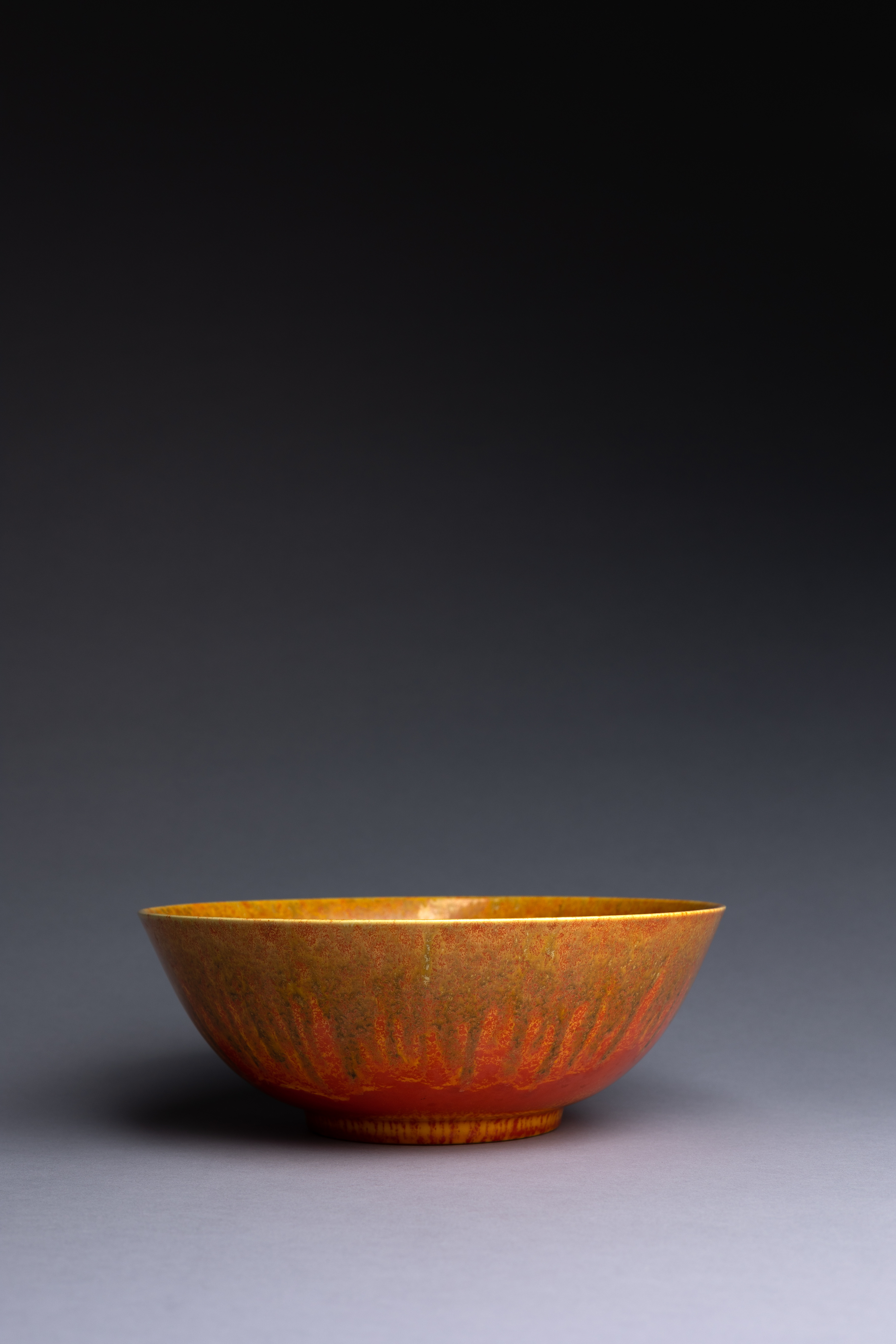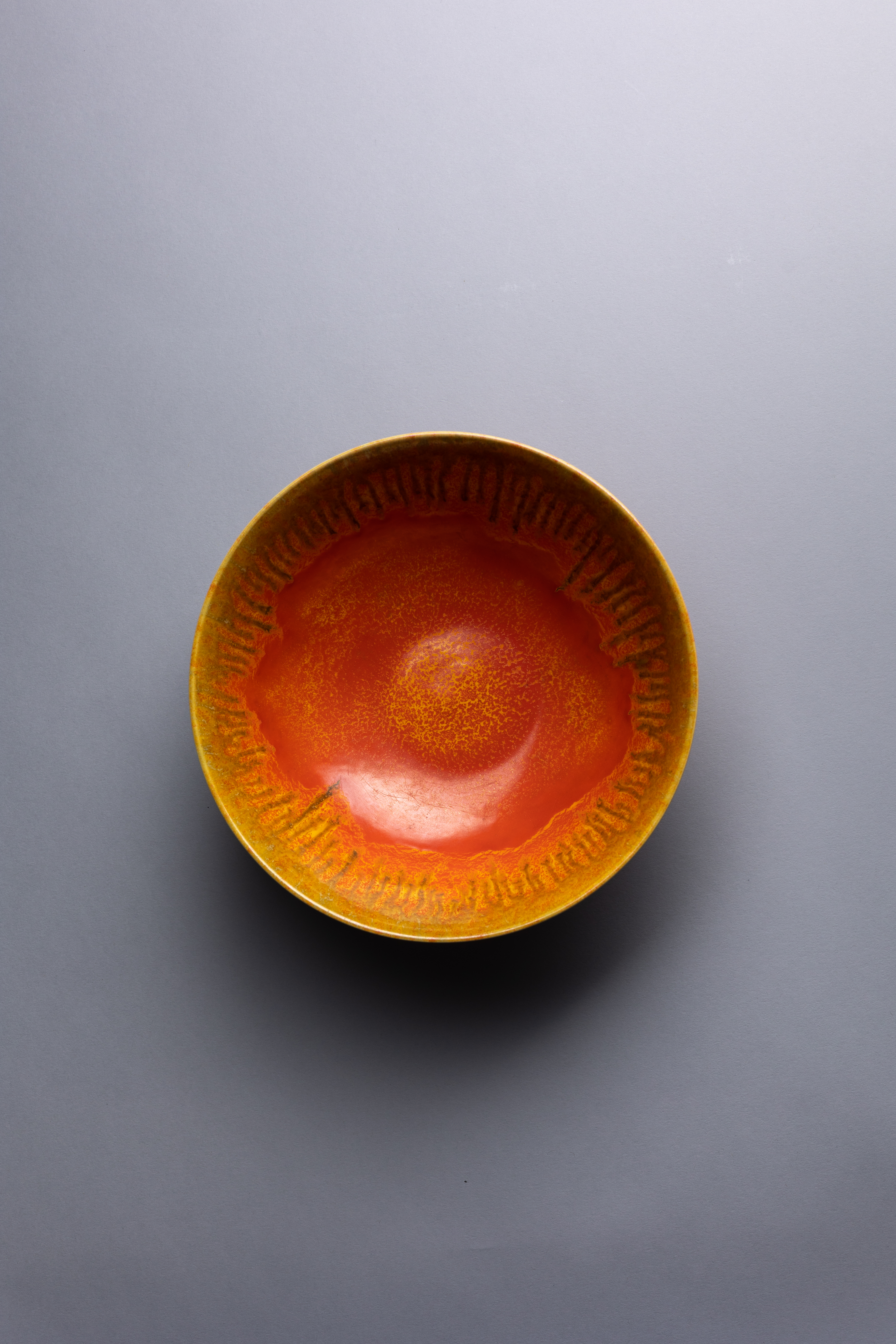Dripping with a gorgeous orange vermilion glaze, this bowl is a fine example of the Pilkington Company’s innovations in artistic glazes.
Dripping with a gorgeous orange vermilion glaze, this bowl is a fine example of the Pilkington Company’s innovations in artistic glazes.
Essay
Pilkingtons Tile and Pottery Company operated throughout the pinnacle years of the British art pottery movement and produced wares that fit within the varied and ever-changing styles of that period. Founded in 1891 at Clifton Junction in Manchester, the company initially produced decorative art tiles which were extremely popular for decorating middle-class homes. It quickly expanded its production lineup to include art pottery wares, employing such famous artists and designers as Walter Crane, C.F.A. Voysey, Lewis F. Day, and Gordon Forsyth.
Pilkingtons used the technical expertise of chemist William Burton, formerly of Wedgwood, to develop a vast range of artistic glazes including a popular ‘Lancastrian Lustre‘. They exhibited their creations at international exhibitions including Paris in 1900, Milan in 1904, Brussels in 1910, and Turin in 1911. The company’s innovation and success resulted in a royal warrant from King George V in 1913, and a subsequent name change to Pilkingtons Royal Lancastrian Pottery Company.
Pilkington’s vermilion glaze range was created around 1930, near the end of the factory’s art pottery production. Pilkington’s vermilion wares feature a deep orange glaze and are faintly flecked with golden speckling which can be seen if the light catches them just right. Darker variations in the glaze were created by allowing crystals of applied metal oxides to develop before firing; once fired, this combustible material produced the darker areas.
While the years of the Arts & Crafts movement were long in the past, this circa 1930 bowl draws on that aesthetic with its clean, unornamented lines and simplicity of materials. At the same time, however, we can see that the design speaks to a style which was just on the horizon: the streamlined modernism of the 1930s.
BT
Condition
Excellent. Very light scratching to the well of the bowl.
For a detailed condition report, please contact us.
Provenance
Pilkingtons Tile and Pottery Company operated throughout the pinnacle years of the British art pottery movement and produced wares that fit within the varied and ever-changing styles of that period. Founded in 1891 at Clifton Junction in Manchester, the company initially produced decorative art tiles which were extremely popular for decorating middle-class homes. It quickly expanded its production lineup to include art pottery wares, employing such famous artists and designers as Walter Crane, C.F.A. Voysey, Lewis F. Day, and Gordon Forsyth.
Pilkingtons used the technical expertise of chemist William Burton, formerly of Wedgwood, to develop a vast range of artistic glazes including a popular ‘Lancastrian Lustre‘. They exhibited their creations at international exhibitions including Paris in 1900, Milan in 1904, Brussels in 1910, and Turin in 1911. The company’s innovation and success resulted in a royal warrant from King George V in 1913, and a subsequent name change to Pilkingtons Royal Lancastrian Pottery Company.
Pilkington’s vermilion glaze range was created around 1930, near the end of the factory’s art pottery production. Pilkington’s vermilion wares feature a deep orange glaze and are faintly flecked with golden speckling which can be seen if the light catches them just right. Darker variations in the glaze were created by allowing crystals of applied metal oxides to develop before firing; once fired, this combustible material produced the darker areas.
While the years of the Arts & Crafts movement were long in the past, this circa 1930 bowl draws on that aesthetic with its clean, unornamented lines and simplicity of materials. At the same time, however, we can see that the design speaks to a style which was just on the horizon: the streamlined modernism of the 1930s.
BT
Excellent. Very light scratching to the well of the bowl.
For a detailed condition report, please contact us.
This item ships free to the continental US, and globally for a flat-rate fee of $75.
All objects are packed with utmost care by our team of expert fine art shippers. All items are shipped with parcel insurance.
For more information on our shipping policies, please visit our FAQ Page.










